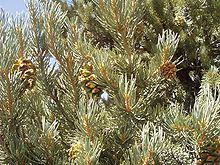| Pinyon pines | |
|---|---|

| |
| Single-leaf pinyon (Pinus monophylla subsp. monophylla) | |
| Scientific classification | |
| Kingdom: | Plantae |
| Clade: | Tracheophytes |
| Clade: | Gymnospermae |
| Division: | Pinophyta |
| Class: | Pinopsida |
| Order: | Pinales |
| Family: | Pinaceae |
| Genus: | Pinus |
| Subgenus: | P. subg. Strobus |
| Section: | P. sect. Parrya |
| Subsection: | P. subsect. Cembroides Engelm.[1] |
| Species | |
|
See text. | |
The pinyon or piñon pine group grows in southwestern North America, especially in New Mexico, Colorado, Arizona, and Utah. The trees yield edible nuts, which are a staple food of Native Americans, and widely eaten as a snack and as an ingredient in New Mexican cuisine. The name comes from the Spanish pino piñonero, a name used for both the American varieties and the stone pine common in Spain, which also produces edible nuts typical of Mediterranean cuisine. Harvesting techniques of the prehistoric American Indians are still used today to collect the pinyon seeds for personal use or for commercialization. The pinyon nut or seed is high in fats and calories. In the western United States, pinyon pines are often found in pinyon–juniper woodlands.
Pinyon wood, especially when burned, has a distinctive fragrance, making it a common wood to burn in chimeneas.[2] Pinyon pine trees are also known to influence the soil in which they grow by increasing concentrations of both macronutrients and micronutrients.[3]
Some of the species are known to hybridize, the most notable ones being P. quadrifolia with P. monophylla, and P. edulis with P. monophylla.
The two-needle piñon (Pinus edulis) is the official state tree of New Mexico.
- ^ Gernandt, D. S.; López, G. G.; García, S. O.; Liston, A. (2005). "Phylogeny and classification of Pinus". Taxon. 54 (1): 42. doi:10.2307/25065300. JSTOR 25065300.
- ^ "Chiminea Woods: Pinon, Apple, and Hickory—Oh My!". Archived from the original on 2014-02-24.
- ^ Barth, R.C. (January 1980). "Influence of Pinyon Pine Trees on Soil Chemical and Physical Properties". Soil Science Society of America Journal. 44 (1): 112–114. Bibcode:1980SSASJ..44..112B. doi:10.2136/sssaj1980.03615995004400010023x. Retrieved 6 August 2012.